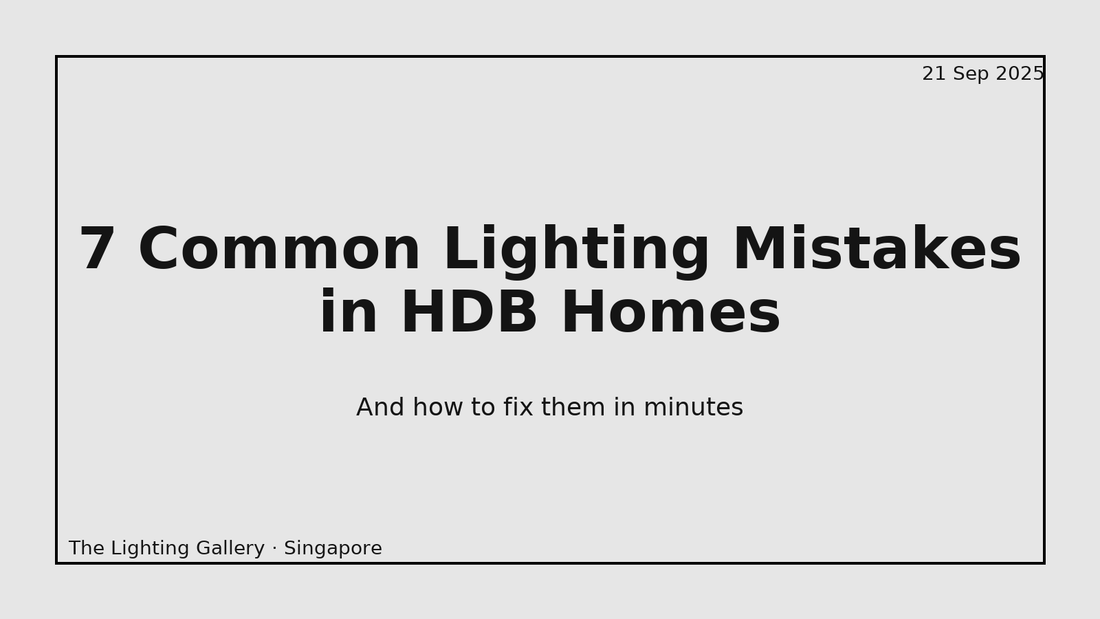
7 Common Lighting Mistakes in HDB Homes (and How to Fix Them)
Share
7 Common Lighting Mistakes in HDB Homes (and How to Fix Them)
Lighting is the most powerful (and most overlooked) design tool in an HDB home. The right plan makes a 3-room flat feel spacious, a dark corridor feel inviting, and your living room look “showroom-ready.” Below are the seven mistakes I see most often—and the exact fixes you can implement this weekend.

1) Relying on a Single Ceiling Light
The problem: One bright fixture creates glare, harsh shadows, and a “flat” look.
The fix: Layer your lighting—combine ambient (ceiling), task (under-cabinet/desk), and accent (wall wash, cove). Even two layers will transform a room.
Quick win: Add a warm LED strip cove to the living room perimeter and a pair of surface spotlights aimed at artwork or shelving.
2) Using the Wrong Colour Temperature
The problem: 6500K everywhere feels sterile; 3000K in work corners feels dim.
The fix:
- Living/Dining/Bedrooms: 2700K–3000K (warm, relaxing)
- Kitchen/Study: 3500K–4000K (neutral, focus)
- Service Yard/Storeroom: 4000K–5000K (clean, bright)
Quick win: In mixed-use rooms, use CCT-tunable strips or install a warm base layer and neutral task lighting.
3) Dark Corridors and Entryways
The problem: Narrow HDB corridors amplify shadows from a single fixture.
The fix: Install continuous LED strip along one side of the ceiling or a wall-wash near skirting to visually widen the passage.
Quick win: A 24V COB strip at 4–6W/m on a dimmer provides soft, hotel-style glow without glare.
4) Glare From Exposed Downlights
The problem: Over-bright, exposed sources cause eye fatigue—especially in low ceilings.
The fix: Choose deep-recessed or trimless gypsum downlights to hide the light source; dim to suit the activity.
Quick win: Replace a row of shallow downlights with 2–3 deep-recessed pieces plus a soft cove strip. Same brightness, far better comfort.
5) Under-Cabinet Shadows in the Kitchen
The problem: Ceiling lights block by your body, leaving the countertop dark.
The fix: Add under-cabinet LED strips with an aluminium profile and diffuser for even, dotless light.
Quick win: Target 100–200 lux on counters; 10W-12W/m strips usually suffice. Add a switch or motion sensor for convenience.
6) Buying the Wrong Driver Size
The problem: Flicker, early failure, or underpowered strips.
The fix: Use this simple rule of thumb:
Driver Wattage = (LED Strip Wattage per metre × Total metres) × 1.25 safety headroom
Example:
24V strip at 12W/m over 5m → 12 × 5 = 60W; 60 × 1.25 = 75W → choose a 100W driver.
Quick win: Keep runs under the maximum recommended length for your strip model, or feed both ends to reduce voltage drop.
7) Ignoring Smart Controls and Dimming
The problem: Lights are either “on” or “off,” so ambience never matches the moment.
The fix: Add dimming and scene presets (e.g., Movie, Work, Dinner). Even a basic wall dimmer transforms the living room.
Quick win: Set everyday use at 70–80% brightness; your eyes relax and strips last longer.
Quick Checklist for a “Showroom-Ready” HDB
- Ambient + Task + Accent layers in every main room
- Warm 2700–3000K for rest zones; 4000K-4500K for work areas
- Deep-recessed or trimless downlights to cut glare
- Under-cabinet strips with diffuser for shadow-free counters
- Correct driver sizing with 25% headroom
- Smart dimming and simple scenes (Movie / Work / Night)
Ready to fix these in one go? Explore:
- COB LED Strips → smooth, dot-free glow (great for coves & under-cabinet)
- 24V Drivers → reliable power with safety headroom
- Trimless/Recessed Downlights → glare-free comfort
-
Surface Spotlights → highlight shelves, artwork, and feature walls
For quick advice, WhatsApp us and share your floor plan. We’ll size the strips and drivers for you in minutes.
FAQs
Q1: Will a brighter (higher-lumen) strip always look better?
Not necessarily. Brightness without diffusion creates harshness. Use an aluminium profile and diffuser where the strip is visible, and dim to taste.
Q2: Can I mix 3000K and 4000K in the same room?
Yes—use warm (3000K) for ambience and neutral (3500–4000K) for task zones. Keep each zone consistent.
Q3: How do I avoid visible LED “dots”?
Choose COB strips or use a diffuser profile. COB is naturally dotless, perfect for coves and under-cabinet runs.
Q4: What if my driver is larger than my calculated need?
Oversizing is fine as long as voltage matches (e.g., 24V strip with 24V driver). Ensure the driver’s maximum current/wattage doesn’t force a constant-current mode—stick to constant-voltage drivers for LED strips.
